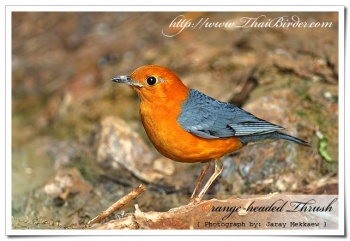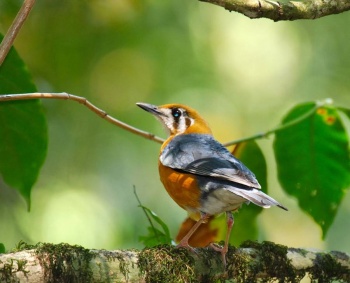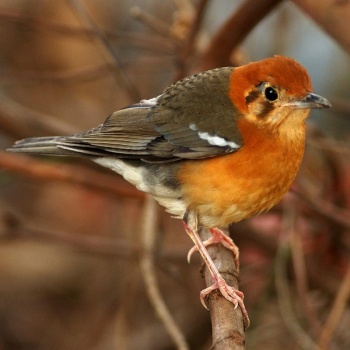Alternative name: Orange-headed Ground-Thrush
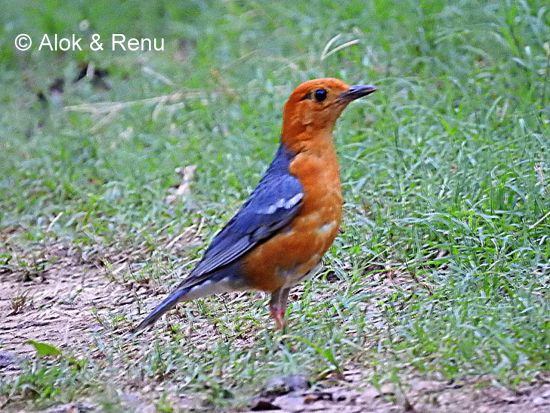
Photo © by Alok Tewari
Jim Corbett National Park, Uttarakhand, India, 10 June 2016
- Geokichla citrina
Zoothera citrina
Includes the White-headed Ground Thrush (Geokichla albogularis); not to be confused with the White-throated Thrush from the Americas
Identification
Total length 20-23 cm (8-9 in).
Males of this small thrush have uniform grey upperparts and orange head and underparts. Females and sub-adults have olive-brown upperparts and tail.
Juveniles of all races have dark facial lines and duller upperparts and underparts with some streaking/mottling.
Variations
The racial variation is striking (see taxonomy), especially in the presence/absence of a white wing-bar and the facial features. Some races have a uniform orange head, some have a slightly duller throat and face with two vertical dark lines (one below the eye and a second on the auriculars), while other have a white face and throat with or without two vertical dark facial lines.
Distribution
Found in well-wooded areas of the Indian subcontinent, southern China, mainland southeast Asia, northern Borneo, Java and Bali.
There are also a few records of migrants from Sumatra. Often local and scarse, but commoner in parts of the India.
Tropical races are generally resident, but races that breed in colder regions (e.g. the Himalayas and parts of China) are migratory and winter further south.
Taxonomy
Formerly placed in genus Zoothera.
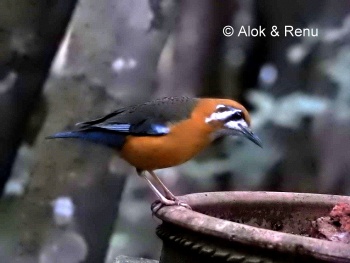
Photo © by Alok Tewari
Amboli, Alt. 22-2500 ft., Western Ghats, Dist. Sindhudurg, Maharashtra, India, 7 february 2019
Subspecies
There are 12 subspecies[1]:
- G. c. citrina: West Pakistan to northern Myanmar; winters to Sri Lanka
- G. c. cyanota: Peninsular India (north to Gujarat and Andhra)
- G. c. innotata: South Myanmar to southern China and Indochina; winters to Malaysia
- G. c. melli: South-East China (Fujian and n Guangdong)
- G. c. courtoisi: East China (Anhui Province)
- G. c. aurimacula: South Vietnam and Hainan
- G. c. andamanensis: Andaman Islands
- G. c. albogularis: Nicobar Islands
- G. c. gibsonhilli: Central Malay Peninsula (southern Myanmar to southern Thailand)
- G. c. aurata: Mountains of northern Borneo
- G. c. rubecula: West Java
- G. c. orientis: East Java and Bali
It has been suggested that some taxa should be considered separate species. Especially albogularis and andamanensis (from the Nicobar and Andaman Islands), the only white-faced and -throated taxa with faint or no vertical dark facial lines, are regularly considered a separate species; the White-throated Ground Thrush (G. albogularis with race andamanensis). Other separations have been suggested, but the variation is confusing with similar-looking races often found far from each other.
Habitat
Found in forest, plantations and secondary growth with some thickets.
Behaviour
Like most Zoothera and Geokichla thrushes it can be quite secretive. They do not form flocks.
Diet
At least partially Crepuscular. It is Omnivorous, eating a wide range of insects, earthworms, termites, leeches, slugs, snails and fruit, berries and grass seed.
Breeding
They nest in trees.
References
- Clements, J. F., T. S. Schulenberg, M. J. Iliff, S. M. Billerman, T. A. Fredericks, B. L. Sullivan, and C. L. Wood. 2019. The eBird/Clements Checklist of Birds of the World: v2019. Downloaded from http://www.birds.cornell.edu/clementschecklist/download/
- Handbook of the Birds of the World Alive (retrieved June 2016)
- BF Member observations
Recommended Citation
- BirdForum Opus contributors. (2025) Orange-headed Thrush. In: BirdForum, the forum for wild birds and birding. Retrieved 15 May 2025 from https://www.birdforum.net/opus/Orange-headed_Thrush
External Links
GSearch checked for 2020 platform.1




